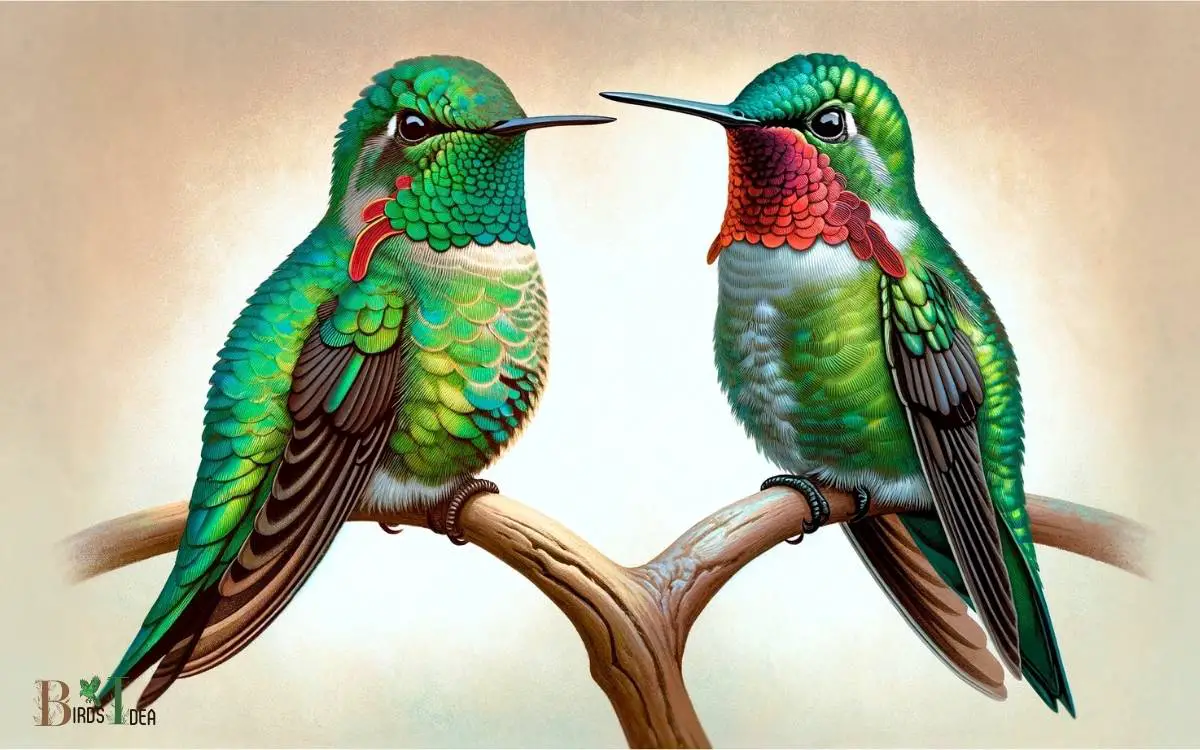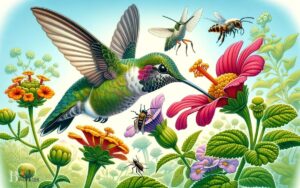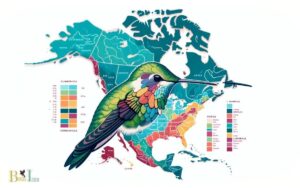Anna’s Hummingbird Male Vs Female: Comparison!
Male and female Anna’s Hummingbirds can be distinguished by their coloration; males have an iridescent emerald back and a rose-red throat, while females sport a green back and a more subdued throat with spots.
Anna’s Hummingbirds exhibit sexual dimorphism, meaning males and females differ in appearance:
Male Anna’s Hummingbird:
Female Anna’s Hummingbird:
Behavioral differences also exist; males perform elaborate dive displays during courtship, which females do not.
The male Anna’s Hummingbird’s striking red throat serves as a beacon during courtship, while the female’s muted tones provide camouflage while nesting.

Key Takeaway
Physical Appearance
The male and female Anna’s hummingbirds can be distinguished by their physical appearance.
Male Anna’s hummingbirds have iridescent crimson-red feathers on their throats and heads, which create a vibrant, dazzling display in the sunlight known as the gorget.
In contrast, the females lack the flashy iridescence and instead have a more muted coloration, with a few iridescent red spots on their throats.
Furthermore, the males have slightly shorter bills compared to the females. Their physical differences are primarily related to breeding and territorial behaviors.
Understanding these distinctions is essential for birdwatchers and researchers studying these hummingbirds to accurately identify and differentiate between the two genders.
Plumage Coloration
The plumage coloration of Anna’s hummingbird plays a significant role in distinguishing between males and females. Male Anna’s hummingbirds are known for their vibrant iridescent throat patches, which can appear to change color depending on the angle of light.
In contrast, females exhibit more subdued coloration, often with a green or bronze hue, allowing for easy differentiation between the sexes.
Male Vibrant Throat
Male Anna’s hummingbirds exhibit vibrant iridescent throat plumage, which is a distinct feature of their appearance. This iridescence is caused by the refraction and scattering of light, rather than pigmentation.
The throat feathers of the male Anna’s hummingbird can appear to change color depending on the angle of the light and the bird’s movements, creating a stunning visual display during courtship rituals.
The vibrant throat plumage serves as a prominent visual cue during mating displays, attracting females and signaling dominance to other males.
This unique characteristic sets the male Anna’s hummingbird apart from other species and adds to its allure.
This vibrant plumage is in stark contrast to the subdued coloration of the female Anna’s hummingbird, which will be discussed in the subsequent section.
Female Subdued Coloration
Exhibiting a subdued plumage coloration, the female Anna’s hummingbird presents a striking contrast to the vibrant iridescence of the male counterpart. The female’s appearance serves a specific purpose in the bird’s natural habitat and life cycle.
The following characteristics define the subdued coloration of the female Anna’s hummingbird:
- Green and Gray Feathers: The female Anna’s hummingbird features predominantly green and gray feathers, providing effective camouflage during nesting and foraging.
- White Tips on Tail Feathers: The tips of the female’s tail feathers are often white, offering subtle yet beautiful accents to her overall appearance.
- Subtle Iridescence: Although less prominent than in males, females also display iridescence, particularly on the throat and crown, adding a touch of understated elegance.
- Molting Patterns: Females exhibit distinct molting patterns, with a periodic shedding and regrowth of feathers to maintain their subdued coloration.
Behavioral Variances
One significant behavioral variance between male and female Anna’s hummingbirds is their courtship displays.
Male Anna’s hummingbirds perform intricate aerial displays to attract females, including steep dives and high-speed U-shaped flights, while producing loud, distinctive sounds with their tail feathers.
Females, on the other hand, observe these displays and select their mates based on the males’ performance.
Additionally, males are territorial and will defend their feeding and perching areas, often engaging in aggressive behaviors towards other males.
In contrast, females focus on building nests and raising their young, displaying more nurturing behaviors.
Understanding these behavioral differences provides insight into the complex dynamics of Anna’s hummingbird interactions and mating rituals, shedding light on the fascinating behaviors of these beautiful creatures.
Mating Rituals
The mating rituals of Anna’s hummingbirds involve intricate courtship displays and selective mate choice, contributing to the complex dynamics of their interactions.
During the mating season, male Anna’s hummingbirds perform elaborate aerial displays to attract females, including daring dives and high-speed chases. These displays showcase the male’s agility and strength as a potential mate.
Female hummingbirds carefully observe these displays and select mates based on the quality of their performance.
Once a female selects a mate, the pair engages in a delicate dance of fluttering and vocalization to solidify their bond.
This selective mating process plays a crucial role in ensuring the survival and success of their offspring.
The intricate courtship displays and selective mate choice among Anna’s hummingbirds underscore the importance of understanding their mating rituals in the broader context of their behavior and ecology, which paves the way for exploring their nesting habits.
Nesting Habits
Displaying remarkable precision and care, both male and female Anna’s hummingbirds exhibit distinct nesting habits, reflecting their specialized adaptations and behaviors.
When it comes to nesting, female Anna’s hummingbirds take on the sole responsibility of building the nest, incubating the eggs, and caring for the hatchlings.
On the other hand, male Anna’s hummingbirds play no role in nesting activities. The nesting habits of these tiny birds are fascinating and essential for their survival.
Here’s a comparison of the nesting habits of male and female Anna’s hummingbirds:
| Nesting Habit | Female Anna’s Hummingbird | Male Anna’s Hummingbird |
|---|---|---|
| Nest Building | Builds the nest alone | Does not build nests |
| Incubation Period | Incubates the eggs | Does not incubate eggs |
| Chick Care | Cares for the hatchlings | Does not care for chicks |
Understanding these nesting habits provides insight into the unique roles and behaviors of male and female Anna’s hummingbirds.
Feeding Preferences
Female Anna’s hummingbirds exhibit a preference for nectar-rich flowers when feeding, while the male counterparts also consume small insects as part of their diet.
This divergence in feeding preferences is due to the differing energetic requirements of the sexes, with females needing more energy for egg production and incubation.
The feeding preferences of Anna’s hummingbirds can be further elaborated as follows:
Female Hummingbirds:
- Prefer nectar-rich flowers
- Consume floral nectar as the primary source of energy
Male Hummingbirds:
- Consume small insects in addition to nectar
- Insects provide additional protein and nutrients for their energetic needs
Understanding the feeding preferences of female and male Anna’s hummingbirds is crucial for conservation efforts and maintaining suitable habitats for these fascinating creatures.
Conclusion
The differences between male and female Anna’s hummingbirds are evident in their physical appearance, plumage coloration, behavioral variances, mating rituals, nesting habits, and feeding preferences.
These distinctions serve to highlight the unique roles and behaviors of each gender within the species.
As the male and female hummingbirds exhibit their individual traits, it becomes clear that their distinct characteristics contribute to the overall diversity and vitality of the Anna’s hummingbird population.






